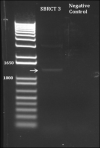High prevalence of CIC fusion with double-homeobox (DUX4) transcription factors in EWSR1-negative undifferentiated small blue round cell sarcomas
- PMID: 22072439
- PMCID: PMC3404826
- DOI: 10.1002/gcc.20945
High prevalence of CIC fusion with double-homeobox (DUX4) transcription factors in EWSR1-negative undifferentiated small blue round cell sarcomas
Abstract
Primitive round cell sarcomas of childhood and young adults have been problematic to diagnose and classify. Our goal was to investigate the pathologic and molecular characteristics of small blue round cell tumors (SBRCT) that remained unclassified after exhaustive immunohistochemistry and molecular screening to exclude known sarcoma-related translocations. As rare examples of EWSR1-negative SBRCT have been shown to carry rearrangements for FUS and CIC genes, we undertook a systematic screening for these two genes. CIC rearrangements by FISH were detected in 15/22 (68%), while none showed FUS abnormalities. RACE, RT-PCR, and/or long-range DNA PCR performed in two cases with frozen material showed that CIC was fused to copies of the DUX4 gene on either 4q35 or 10q26.3. Subsequent FISH analysis confirmed fused signals of CIC with either 4q35 or 10q26.3 region in six cases each. Tumors positive for CIC-DUX4 fusion occurred mainly in male young adult patients (median age: 29 years), with the extremities being the most frequent location. Microscopically, tumors displayed a primitive, round to oval cell morphology with prominent nucleoli, high mitotic count, and areas of necrosis. O13 expression was variable, being either diffuse or patchy and tumors mostly lacked other markers of differentiation. Although CIC-DUX4 resulting in a t(4;19) translocation has been previously described in primitive sarcomas, this is the first report implicating the related DUX4 on 10q26 in oncogenesis. These results suggest the possibility of a newly defined subgroup of primitive round cell sarcomas characterized by CIC rearrangements, distinct from Ewing sarcoma family of tumors.
Copyright © 2011 Wiley-Liss, Inc.
Figures









References
-
- Alaggio R, Bisogno G, Rosato A, Ninfo V, Coffin CM. Undifferentiated sarcoma: does it exist? A clinicopathologic study of 7 pediatric cases and review of literature. Hum Pathol. 2009;40:1600–1610. - PubMed
-
- Antonescu CR, Zhang L, Chang NE, Pawel BR, Travis W, Katabi N, Edelman M, Rosenberg AE, Nielsen GP, Dal Cin P, Fletcher CD. EWSR1-POU5F1 fusion in soft tissue myoepithelial tumors. A molecular analysis of sixty-six cases, including soft tissue, bone, and visceral lesions, showing common involvement of the EWSR1 gene. Genes Chromosomes Cancer. 2010;49:1114–1124. - PMC - PubMed
-
- Balamuth NJ, Womer RB. Ewing’s sarcoma. Lancet Oncol. 2010;11:184–192. - PubMed
-
- Berg T, Kalsaas AH, Buechner J, Busund LT. Ewing sarcoma-peripheral neuroectodermal tumor of the kidney with a FUS-ERG fusion transcript. Cancer Genet Cytogenet. 2009;194:53–57. - PubMed
-
- Blay JY, Le Cesne A. Adjuvant chemotherapy in localized soft tissue sarcomas: still not proven. Oncologist. 2009;14:1013–1020. - PubMed
Publication types
MeSH terms
Substances
Supplementary concepts
Grants and funding
LinkOut - more resources
Full Text Sources
Other Literature Sources
Research Materials
Miscellaneous

